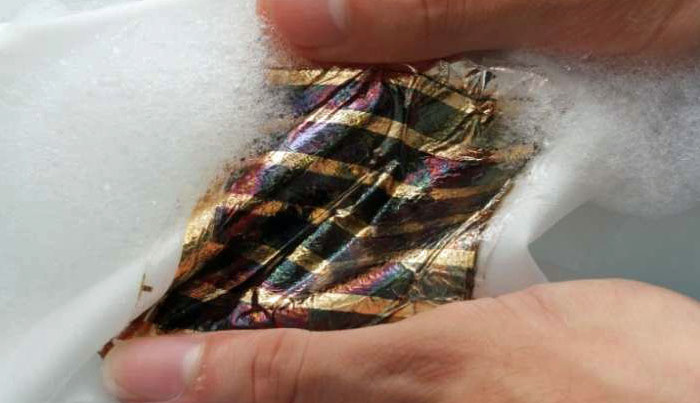Stretchable/washable solar cells
September 21, 2017
on
on

Scientists from the Japanese research institute RIKEN and the University of Tokyo have developed bendable and stretchy ultra-thin solar cells which continue to generate electricity from sunlight even after soaking in water and when compressed or stretched.
The research results were published in the journal Nature Energy and describe a photo-voltaic material that could be used to make outer garments and provide power for wearable devices. One of the challenges of the Internet-of-Things concept is the requirement of a reliable power source to keep all devices connected. Previous wearable solar cell solutions suffered from the absence of at least one of the important properties i.e. long-term stability in air and water, energy efficiency and robustness, including resistance to deformation.
The research group succeeded in developing extremely thin and flexible organic solar cells using a material called PNTz4T, which they had developed earlier. The electro-optic layers are applied to a 1 μm thin parylene film. This ultra-thin assembly is then applied to an acrylic-based elastomer, and over-coated with an identical elastomer to prevent ingress of water from either side, but allowing the passage of light. The construction method has also proved to be particularly durable.
The researchers subjected the solar cells to a variety of stretchability and stability-in-water tests and found the material maintained an efficiency of 7.9%, which corresponds to a power density of 7.86 mW / cm². The efficiency of double-side-coated devices decreased by only 5.4% after immersion in water for two hours. The efficiency of the devices also remained at 80% of the initial value even after 52% mechanical compression for 20 cycles with 100 min of water exposure. These properties make this type of solar cell ideal for integration into garments, supplying power for wearable electronics.
The research results were published in the journal Nature Energy and describe a photo-voltaic material that could be used to make outer garments and provide power for wearable devices. One of the challenges of the Internet-of-Things concept is the requirement of a reliable power source to keep all devices connected. Previous wearable solar cell solutions suffered from the absence of at least one of the important properties i.e. long-term stability in air and water, energy efficiency and robustness, including resistance to deformation.
The research group succeeded in developing extremely thin and flexible organic solar cells using a material called PNTz4T, which they had developed earlier. The electro-optic layers are applied to a 1 μm thin parylene film. This ultra-thin assembly is then applied to an acrylic-based elastomer, and over-coated with an identical elastomer to prevent ingress of water from either side, but allowing the passage of light. The construction method has also proved to be particularly durable.
The researchers subjected the solar cells to a variety of stretchability and stability-in-water tests and found the material maintained an efficiency of 7.9%, which corresponds to a power density of 7.86 mW / cm². The efficiency of double-side-coated devices decreased by only 5.4% after immersion in water for two hours. The efficiency of the devices also remained at 80% of the initial value even after 52% mechanical compression for 20 cycles with 100 min of water exposure. These properties make this type of solar cell ideal for integration into garments, supplying power for wearable electronics.
Read full article
Hide full article



Discussion (0 comments)